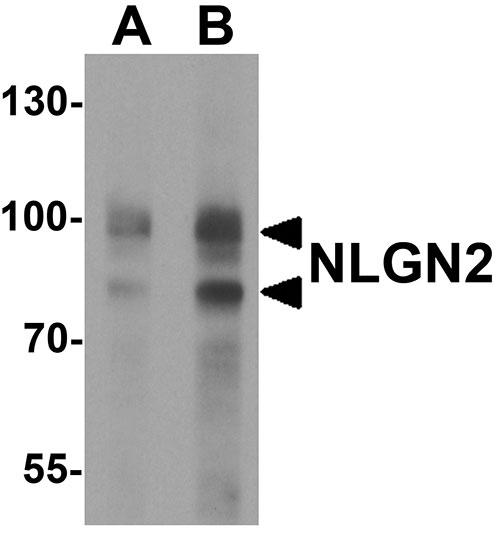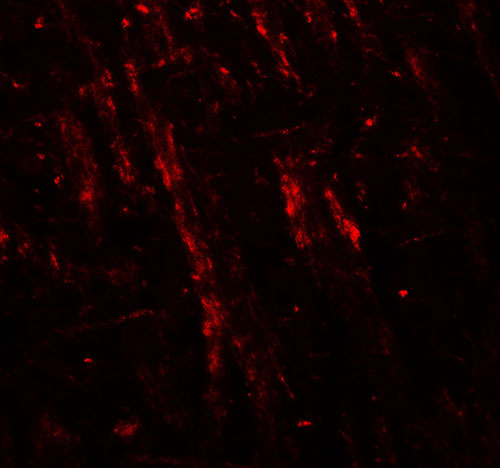NLGN2 Antibody
- 产品详情
- 实验流程
- 背景知识
Application
| WB, IF, E, IHC-P |
|---|---|
| Primary Accession | Q8NFZ4 |
| Other Accession | NP_065846, 30840978 |
| Reactivity | Human, Mouse, Rat |
| Host | Rabbit |
| Clonality | Polyclonal |
| Isotype | IgG |
| Calculated MW | 90820 Da |
| Concentration (mg/ml) | 1 mg/mL |
| Conjugate | Unconjugated |
| Application Notes | NLGN2 antibody can be used for detection of NLGN2 by Western blot at 1 - 2 µg/ml. Antibody can also be used for immunohistochemistry starting at 5 µg/mL. For immunofluorescence start at 20 µg/mL. |
| Gene ID | 57555 |
|---|---|
| Other Names | Neuroligin-2, NLGN2, KIAA1366 |
| Target/Specificity | NLGN2; NLGN2 antibody is human, mouse and rat reactive. At least two isoforms are known to exist; this antibody will detect both isoforms. NLGN2 antibody is predicted to not cross-react with other members of the NLGN protein family. |
| Reconstitution & Storage | NLGN2 antibody can be stored at 4℃ for three months and -20℃, stable for up to one year. |
| Precautions | NLGN2 Antibody is for research use only and not for use in diagnostic or therapeutic procedures. |
| Name | NLGN2 |
|---|---|
| Synonyms | KIAA1366 |
| Function | Transmembrane scaffolding protein involved in cell-cell interactions via its interactions with neurexin family members. Mediates cell-cell interactions both in neurons and in other types of cells, such as Langerhans beta cells. Plays a role in synapse function and synaptic signal transmission, especially via gamma-aminobutyric acid receptors (GABA(A) receptors). Functions by recruiting and clustering synaptic proteins. Promotes clustering of postsynaptic GABRG2 and GPHN. Promotes clustering of postsynaptic LHFPL4 (By similarity). Modulates signaling by inhibitory synapses, and thereby plays a role in controlling the ratio of signaling by excitatory and inhibitory synapses and information processing. Required for normal signal amplitude from inhibitory synapses, but is not essential for normal signal frequency. May promote the initial formation of synapses, but is not essential for this. In vitro, triggers the de novo formation of presynaptic structures. Mediates cell-cell interactions between Langerhans beta cells and modulates insulin secretion (By similarity). |
| Cellular Location | Cell membrane; Single-pass type I membrane protein. Postsynaptic cell membrane. Presynaptic cell membrane. Note=Detected at postsynaptic membranes in brain. Detected at dendritic spines in cultured neurons. Colocalizes with GPHN and ARHGEF9 at neuronal cell membranes (By similarity). Localized at presynaptic membranes in retina. Colocalizes with GABRG2 at inhibitory synapses in the retina (By similarity). |
| Tissue Location | Expressed in the blood vessel walls. Detected in colon, brain and pancreas islets of Langerhans (at protein level) Detected in brain, and at lower levels in pancreas islet beta cells |
For Research Use Only. Not For Use In Diagnostic Procedures.
Provided below are standard protocols that you may find useful for product applications.
BACKGROUND
Neuroligin 2 (NLGN2) is a member of a family of neuronal cell surface proteins that localize to the post-synaptic membrane (1,2). Neuroligins are thought to act as splice site-specific ligands for beta-neurexins and may be involved in the formation and remodeling of central nervous system synapses (2). NLGN2 has been shown to control perisomatic inhibitory synapse maturation together with gephyrin and collybistin, thereby regulating GABA receptor clustering on neurons (3,4). NLGN2 also exhibits differential functions at different types of inhibitory synapses on the same postsynaptic neuron (5).
REFERENCES
Ichtchenko K, Nguyen T, and Sudhof TC. Structures, alternative splicing, and neurexin binding of multiple neuroligins. J. Biol. Chem. 1996; 271:2676-82.
Bang ML and Owczarek S. A matter of balance: role of neurexin and neuroligin at the synapse. Neurochem. Res. 2013; 38:1174-89.
Poulopoulos A, Aramuni G, Meyer G, et al. Neuroligin 2 drives postsynaptic assembly at perisomatic inhibitiory synapses through gephyrin and collybistin. Neuron 2009; 63:628-42.
Jedlicka P, Hoon M, Poulopoulos T, et al. Increased dentate gyrus excitability in neuroligin-2-deficient mice in vivo. Cereb. Cortex 2011; 21:357-67.
终于等到您。ABCEPTA(百远生物)抗体产品。
点击下方“我要评价 ”按钮提交您的反馈信息,您的反馈和评价是我们最宝贵的财富之一,
我们将在1-3个工作日内处理您的反馈信息。
如有疑问,联系:0512-88856768 tech-china@abcepta.com.























 癌症的基本特征包括细胞增殖、血管生成、迁移、凋亡逃避机制和细胞永生等。找到癌症发生过程中这些通路的关键标记物和对应的抗体用于检测至关重要。
癌症的基本特征包括细胞增殖、血管生成、迁移、凋亡逃避机制和细胞永生等。找到癌症发生过程中这些通路的关键标记物和对应的抗体用于检测至关重要。 为您推荐一个泛素化位点预测神器——泛素化分析工具,可以为您的蛋白的泛素化位点作出预测和评分。
为您推荐一个泛素化位点预测神器——泛素化分析工具,可以为您的蛋白的泛素化位点作出预测和评分。 细胞自噬受体图形绘图工具为你的蛋白的细胞受体结合位点作出预测和评分,识别结合到自噬通路中的蛋白是非常重要的,便于让我们理解自噬在正常生理、病理过程中的作用,如发育、细胞分化、神经退化性疾病、压力条件下、感染和癌症。
细胞自噬受体图形绘图工具为你的蛋白的细胞受体结合位点作出预测和评分,识别结合到自噬通路中的蛋白是非常重要的,便于让我们理解自噬在正常生理、病理过程中的作用,如发育、细胞分化、神经退化性疾病、压力条件下、感染和癌症。








